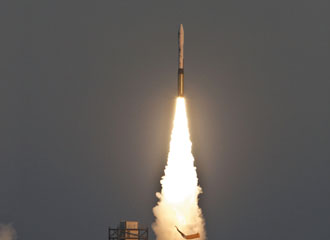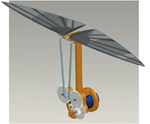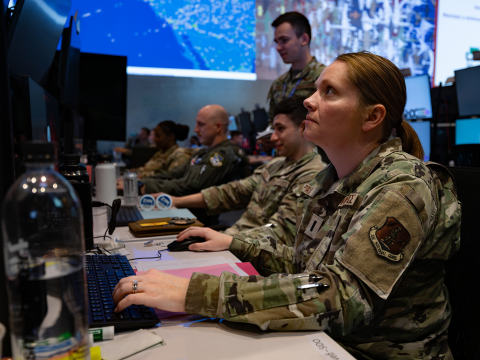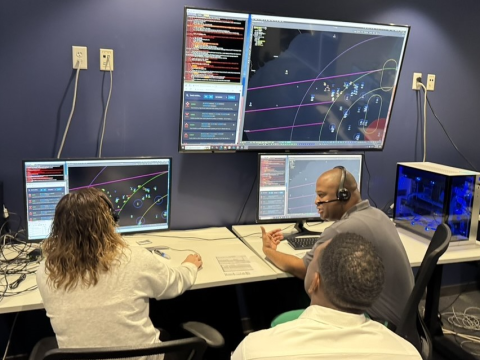Air Force Research Aims at Undefined Future
 |
A U.S. Air Force Minotaur rocket launches TacSat-3 and two other research satellites into orbit from Wallops Island, Virginia. Future Air Force satellites may be smaller and more numerous to provide greater flexibility of operation. |
The future air battlespace may be dominated by unmanned aerial vehicles fully networked to exchange sensor information and battle damage assessments. They could be controlled remotely by human pilots or guided by autonomous programming that allows them to change their objective mid-mission like a flock of birds suddenly changing direction. Similarly, they might trade off capabilities to ensure mission success if one or more fails or is destroyed.
U.S. Air Force researchers are pursuing goals that may lead to this future force sooner rather than later. Their efforts span the range of disciplines normally associated with aircraft development, but their research also includes non-aviation-specific areas that will benefit the future force. And, Air Force laboratories are embracing cross-domain research that acknowledges the cross-over nature of innovation and development.
Maj. Gen. Curtis M. Bedke, USAF, is the commander of the Air Force Research Laboratory (AFRL). Scheduled to retire from the Air Force this spring, Gen. Bedke has shaped Air Force research to suit the needs of what may be the most technologically defined service in the
The AFRL must lead the Air Force into an uncertain future, both in terms of mission and technologies. “We need to be able to answer the questions that the Air Force doesn’t even necessarily know to ask,” Gen. Bedke declares. Instead of requirements pull, which is the focus of responding to warfighter needs, the AFRL must engage in technology push entailing leading-edge science. And, if it is successful, the AFRL will be creating a technology push that ultimately may trigger a requirements pull.
This research—whether practical or esoteric, near- or long-term—aims to generate tangible advances in Air Force capabilities, and some of them may be appearing soon. Gen. Bedke predicts that the Air Force will be flying more unmanned systems, and these will be smaller and more specialized.
In space, satellites also will be smaller and more numerous. They will be simpler than the large, exquisite orbiters that tend to define traditional Air Force space assets. Each one may be designed to perform a specific function that is complementary to that of other orbiters.
In the tilt away from large and exquisite, the smaller less-expensive unmanned platforms in the air and in space also will be more disposable, Gen. Bedke notes. And, if some platforms are disabled or destroyed, others could step up and assume their roles.
Regardless of their specific functions, all platforms will become sensor systems, and they will be tied to a common grid. This applies to both air and space assets. These unmanned assets will become more autonomous, as planners will think of a remotely piloted aircraft “more as being a brain with wings,” the general suggests.
With all systems serving as sensor platforms, their autonomy also could increase. Some vehicles in a fleet of unmanned aircraft might detect a new threat, for which the other vehicles might take evasive action or even change course together. Some vehicles might be assigned automatically to neutralize this new threat or to change their mission priority to a new target. Humans would remain in the loop to monitor or guide mission activities as needed, the general notes.
“I think of that as lots of flying brains making real-time decisions all within the parameters of the rules of engagement established ahead of time,” he states.
The same approach can be taken with satellites. Different capabilities would be spread out among a cluster of orbiters so that the loss of one to enemy action would not remove that capability from orbit. One possible architecture would feature a constellation of satellites in which no one spacecraft has any capability, but the cluster together forms a capability that would survive the loss of one or more of its members. This might apply to a sensor system that, instead of featuring a giant antenna on a large satellite, entails much smaller systems on minisatellites that provide the same data—much in the same manner as a ground-based array of radio telescopes that provides deep-space sensing capabilities.
In addition to being smaller and more autonomous, assets will be more cross-domain than they are today. In effect, cross-domain functionality will be the jointness of the future. Planners will need to shun stovepipe-domain systems in favor of systems that can operate across domains where appropriate.
“Not only do we need to think about air, space and cyber and working in all three domains, [but also] we need to be thinking about the fact that all three of those domains increasingly overlap,” Gen. Bedke points out. “So, something that affects one probably will affect the other two. And in fact, if we’re smart, we’ll be thinking about how those can affect each of the domains.”
The dynamic battle environment that characterizes today’s warfighting is a major driver for these smaller, faster, less-expensive systems. But the general emphasizes that they are not being conceived to react to changes in the battlespace. Rather, the aim is for these systems to shape the battlespace to suit
Yet even with a road map for long-term gains, the AFRL responds quickly to near-term requirements. As with all the services, the Air Force places its highest priority on responding to the needs of the warfighter. Its efforts include launching programs requested by warfighters in addition to fulfilling urgent requirements from the front. The AFRL must be able to react to immediate needs and continue to transition technology to the warfighter, the general emphasizes.
One such urgent request involved helicopter brownout—a situation that emerges when a helicopter approaching the ground in an arid climate such as Iraq or Afghanistan kicks up so much dust and dirt that the pilot suddenly loses visibility and orientation as the craft is about to land. Helicopter brownouts have killed many people in both countries, so the AFRL was asked to develop a solution that would be both rapid and inexpensive.
 |
Air Force Research Laboratory-funded scientists are examining flexible, flapping wings such such as those of bats, birds and insects for possible designs of future micro air vehicles. Unmanned air vehicles of all sizes, shapes and functions may dominate the airspace over a future battlefield. |
Another example involves the fight against improvised explosive devices, or IEDs. The Joint IED Defeat Organization (JIEDDO) asked the AFRL for a solution to a specific challenge it was facing. Experts at the AFRL offered 25 possible solutions, which were examined by JIEDDO in a three-day session. The 25 suggestions were whittled down to six solutions that were funded by JIEDDO. One proposed solution ultimately was abandoned, but all of the other five were pursued for possible use against enemy IEDs. Gen. Bedke explains that the AFRL and JIEDDO continued to develop five solutions because they offered a variety of defensive measures that could be employed if the enemy countered one or two of them.
But while it continues to support the warfighter today, the AFRL has determined that the biggest challenges it faces cannot be solved by any single scientific discipline. Only by ensuring that researchers at these different disciplines work together can these challenges be overcome. Gen. Bedke notes that, where in the past the Air Force relied on its different technical directorates to conduct research independently, now the toughest problems may require as many as seven directorates working across organizational lines toward a common goal. He describes this as the single biggest perspective change required by the AFRL.
“It’s not [done] in order to gain control; it is to be able to ensure that we’re working on the right things by taking that bigger perspective and not accepting, ‘gee, that’s too big for us to handle by ourselves’ as an answer,” the general says.
So, instead of organizing research along the lines of its technical directorates, the AFRL concentrates its efforts according to eight focused long-term challenges, or FLTCs. Gen. Bedke describes them as technology mission areas rather than as problems to solve.
The eight FLTCs are anticipatory command, control and intelligence; unprecedented proactive intelligence, surveillance and reconnaissance; dominant difficult surface target engagement/defeat, which would involve attacking hardened or hidden targets; persistent and responsive precision engagement, which would increase loiter time and enable precise and rapid response; assured operations in high-threat environments, which would entail protecting assets ranging from satellites and aircraft to cyberspace and people on the ground; dominant offensive cyber engagement; on-demand force projection, anywhere; and affordable mission generation and sustainment. Gen. Bedke emphasizes that most, if not all, of these FLTCs are expected to be domain-agnostic.
Even with the FLTCs, the AFRL is retaining its technical directorates because they all possess core competencies encompassing valuable expertise, the general continues. Gen. Bedke emphasizes that, instead of reorganizing along the lines of the FLTCs, the Air Force determined that a better course would be to have experts in each group feeding off each other to maintain their edge, and then reaching out to outside experts as needed on a specific project.
But the best way to generate leading-edge science and technology is through collaboration, he says, so all of the technology directorates are working on each of these FLTCs. And, eight technology directors are dual-hatted as FLTC directors. Each FLTC director is tasked with assembling a portfolio of problems as well as capability concepts that would solve the respective FLTC problems. Communication and collaboration among these directors are essential for them to fulfill their missions.
These FLTC directors develop capability concepts that offer solutions for near-, mid- and long-term time frames. The technical directorates also set aside funds for what is known as discovery research. Gen. Bedke describes this as research that may open the door to vitally important technologies that might not fall under an FLTC category. Some examples of discovery research include esoteric topics such as Bose-Einstein condensates, which entails cooling matter to within one ten-millionth of a degree above absolute zero where quantum effects begin to appear. Another example is quantum computing research, which will affect every FLTC in one way or another even if those ways are not yet clear, the general declares.
Over the past two years, the ratio of money spent on FLTC vs. discovery research has shifted from 2:3 to 4:1. This does not represent a shift away from long-term to short-term research, Gen. Bedke allows. Rather, it represents an evolution toward better definition of research. For example, a research effort that will pay only long-term benefits meets FLTC criteria if its benefits would solve a specific FLTC.
One innovative approach to addressing the FLTCs is what the general describes as an n-dimensional Rubik’s cube. For example, the Air Force operates in three domains: air, space and cyber. Any potential solution for one domain must consider whether an equivalent exists in either or both of the other two domains. This multiconsideration approach also applies to capabilities in general. If an offensive capability is developed, researchers also must consider if a defensive capability exists that could counter the offensive one. Similarly, researchers must consider the exploitation that falls somewhere in between. This approach applies especially to cyber, the general notes.
More important is the ability to take all of these challenges and capabilities into account. This approach goes far beyond the simple three-dimensional thinking that characterizes the examples. A single element of that Rubik’s cube—a cubelet—might be either overworked or underemphasized to the detriment of the overall challenge or mission area, and that imbalance would need to be addressed.
WEB RESOURCE



Comments